Posts Tagged ‘Easter’
-
A CURIOUS DISCOVERY
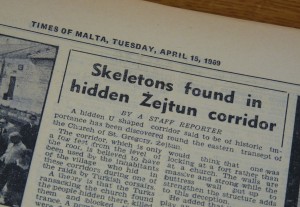 Skeletons found in hidden Żejtun corridor reported the Times of Malta on Tuesday, 15 April 1969. A photo of sacristan Ġann Marì Debono holding a skull in his hand accompanied the news of this remarkable discovery which up to this day is still shrouded in mystery and imbued with controversy.
Skeletons found in hidden Żejtun corridor reported the Times of Malta on Tuesday, 15 April 1969. A photo of sacristan Ġann Marì Debono holding a skull in his hand accompanied the news of this remarkable discovery which up to this day is still shrouded in mystery and imbued with controversy.I have been investigating and researching this find, often by interviewing persons who declared to have been involved in this discovery. My findings were discussed during a national symposium which was organized by Wirt iż-Żejtun in 2014 and later published in the book The Turkish Raid of 1614 which was issued by the same NGO.
 I never got the opportunity to talk to Ġann Marì Debono since he passed away in 2001, at the age of 78. Therefore, I accepted gladly the invitation of his eldest son Charles Debono who offered to share with me his father’s story.
I never got the opportunity to talk to Ġann Marì Debono since he passed away in 2001, at the age of 78. Therefore, I accepted gladly the invitation of his eldest son Charles Debono who offered to share with me his father’s story.“My grandmother had many children and so my father was brought up by his uncle Pawlu and his wife Beneditta Fenech. Pawlu was the sacristan of the parish church of St Catherine in Żejtun and he often took my father with him while he was at work. Soon, my father got very fond of this job and he gave a hand to his uncle whenever he could. Eventually, when Pawlu died, my father took over his duties and he became the new sacristan.”
Along the years, the old church of St Gregory which originally was the parish church of the village, had become neglected.
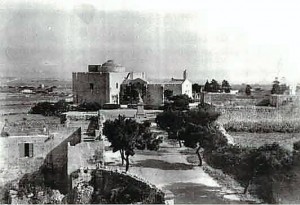 “There was nothing but a few farmhouses in the area. However, when a housing estate was built in proximity to this church, it made sense to revamp this building to provide service to the inhabitants who lived close by. Since my father was considering leaving his job at the parish church, Fr Ġwann Palmier, who was responsible for St Gregory’s church and also a friend of his, offered him a job there. Soon, my father was appointed as the sacristan of this church and together with Fr Palmier, they began to restore the place back to its glory.”
“There was nothing but a few farmhouses in the area. However, when a housing estate was built in proximity to this church, it made sense to revamp this building to provide service to the inhabitants who lived close by. Since my father was considering leaving his job at the parish church, Fr Ġwann Palmier, who was responsible for St Gregory’s church and also a friend of his, offered him a job there. Soon, my father was appointed as the sacristan of this church and together with Fr Palmier, they began to restore the place back to its glory.”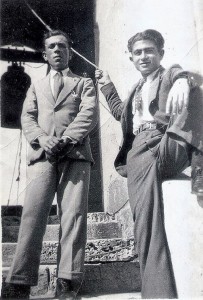 “My father was blessed with a curious nature and a strong determination. He had often listened to the rumours of the old villagers who insisted that there were some people that were buried around the dome of St Gregory’s church. He tried hard to locate this area, especially while doing maintenance work around the dome but he never succeeded.”
“My father was blessed with a curious nature and a strong determination. He had often listened to the rumours of the old villagers who insisted that there were some people that were buried around the dome of St Gregory’s church. He tried hard to locate this area, especially while doing maintenance work around the dome but he never succeeded.”Time would reveal that this was an impossible task since the human remains were actually buried around the roof and not around the dome.
“There was a raised stone close to the exit of the stairway’s room which led to the roof. My father often commented that it looked unusual and out of place. He was convinced that there was something beneath it. One day, there were some men doing maintenance work on the roof and he asked them to try to remove it.”
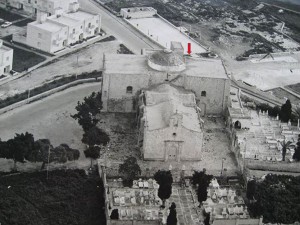 “Once the stone was removed, it was clear that it was covering an opening which led into the church. When my father entered into this space, he found his way to a small chamber which led to U-shaped passages that ran around the roof. Inside the corridors, he found several human remains. I remember him coming home on that day, full of excitement and telling us ‘I found them! I finally found them! I will take you to see them!’”
“Once the stone was removed, it was clear that it was covering an opening which led into the church. When my father entered into this space, he found his way to a small chamber which led to U-shaped passages that ran around the roof. Inside the corridors, he found several human remains. I remember him coming home on that day, full of excitement and telling us ‘I found them! I finally found them! I will take you to see them!’”When Charles visited the passages with his father, he noticed that the skeletons seemed to be lined up near each other along the corridors, as if someone had arranged them in that way. There was about 3 centimetres of dust which had collected in the corridors along the years during which the passages were blocked and closed away.
 Within this dust, a wooden shoe sole with a high heel, a small gilded wooden cross of Byzantine design, odd bits of a gilded wooden frame (perhaps an icon), three coins: two bronze with the cross of the Order, the other gold, but very worn out that it cannot be deciphered, pieces of pottery of the 16-17th century, fragments of animal bones, and a part of a chain mail armour vest, were discovered.
Within this dust, a wooden shoe sole with a high heel, a small gilded wooden cross of Byzantine design, odd bits of a gilded wooden frame (perhaps an icon), three coins: two bronze with the cross of the Order, the other gold, but very worn out that it cannot be deciphered, pieces of pottery of the 16-17th century, fragments of animal bones, and a part of a chain mail armour vest, were discovered.“My father found these passages in pitch darkness but soon he noticed that there were stones blocking five narrow loopholes in the thick walls. Once he removed these stones, he realized that three of them were pointing directly at St Thomas Bay and Marsascala while the other two looked out at Marsaxlokk and Birżebbuġa.”
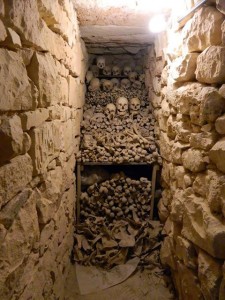 To avoid them being trodden, Debono picked up all the human bones and stacked them at the end of the third corridor. Yet the story does not end there….
To avoid them being trodden, Debono picked up all the human bones and stacked them at the end of the third corridor. Yet the story does not end there….“My father was sure that there was another entrance to these passages within the church itself. He pondered this idea and made several attempts to trace it out. Eventually he came upon a wall cupboard which was situated in an area along the winding staircase and seemed to be of no use. He decided to ask his friend Ġanni Vella, who was known as Ġanni l-ġgant (Ġanni the giant), to bring one of his mason’s tools; a huge iron nail with which building stones were kept in place. He knocked on the wall cupboard with this tool and suddenly, this feature moved out of the wall, revealing another entrance to these passages. It is from this entrance that people get in to view these passages nowadays.”
In 1978, paleopathological studies were done on these human remains by Seshadri Ramaswamy and Joseph Leslie Pace. These experts concluded that the bones appeared to have been exhumed from a cemetery and placed in the passages. However, others find this conclusion hard to believe and they insist that these remains possibly belong to a group of people who were trapped in these corridors whilst hiding there during an Ottoman attack on the village in 1614.
 Every Wednesday after Easter, the traditional feast of St Gregory is celebrated in this historical church in Żejtun. Probably few of those attending are aware of the secret passages and the human skeletons lying within.
Every Wednesday after Easter, the traditional feast of St Gregory is celebrated in this historical church in Żejtun. Probably few of those attending are aware of the secret passages and the human skeletons lying within.Considering that 49 years have passed from this discovery and that several scientific tools are now available to provide more conclusive results, including perhaps dna tests to trace family ancestry, isn’t it time to resolve this mystery by identifying who are these people and how they ended up in these passages?
(This feature was published in the Sunday Times of Malta issued on 25 March 2018)
-
Take me to church
“ ‘They have hit our church!’ cried a man as he stumbled down in the tunnel which was located under the Mall Garden. We were huddling in there for shelter together with many other people as the bombs came down over Floriana,” reminisced Pawlu Piscopo who was eight at the time.
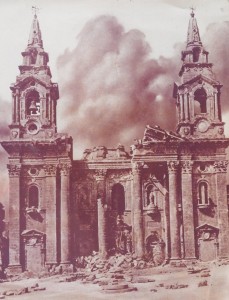 “At this horrible news, my father grabbed me and my brother by the hand and took us out of the tunnel and over to the granaries where a very sad spectacle awaited us. St Publius’ Church had suffered a direct hit. Its dome was gone and the area was surrounded in rubble. Thirteen people who were taking cover in the church’s crypt were killed and eleven more were injured. That was the blackest moment in the history of the parish church of Floriana: April 28, 1942 at 7:50am.”
“At this horrible news, my father grabbed me and my brother by the hand and took us out of the tunnel and over to the granaries where a very sad spectacle awaited us. St Publius’ Church had suffered a direct hit. Its dome was gone and the area was surrounded in rubble. Thirteen people who were taking cover in the church’s crypt were killed and eleven more were injured. That was the blackest moment in the history of the parish church of Floriana: April 28, 1942 at 7:50am.”After their house had been bombed, Pawlu’s family were allowed to take some respite in a large residence which today houses the Floriana Local Council. Yet for four years, they lived mostly underground in this tunnel which probably saved their lives. They took with them only a few belongings and the most cherished items, including a statue of St Publius which dated back to 1928 and used to adorn the model altar that his father had constructed at home.
“Most families in Malta had a model of an altar or a miniature church at home at the time. Unfortunately, many of these had to be abandoned during the war and a good number of them were destroyed when the houses were bombed.”
The craft of church model-making had been introduced to our islands by the Knights of St John back in the 16th century, and therefore its knowledge was a distinct tradition. However the adversity of war ravaged even this precious memory until eventually this craft was almost completely forgotten.
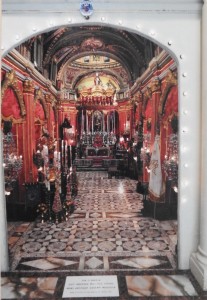 “After the war, people tried to get on with their lives as best as they could. Shops started to open again but those that used to sell miniature items with which to decorate our religious models, dwindled down to almost none. Nevertheless, the passion for model-making was much engrained in our family and when I bought a miniature structure made of four columns and a dome from a man who was leaving Malta to go to live in Australia, my father Carmelo was inspired to use it as the foundation for a model of St Publius’ church,” explained Pawlu.
“After the war, people tried to get on with their lives as best as they could. Shops started to open again but those that used to sell miniature items with which to decorate our religious models, dwindled down to almost none. Nevertheless, the passion for model-making was much engrained in our family and when I bought a miniature structure made of four columns and a dome from a man who was leaving Malta to go to live in Australia, my father Carmelo was inspired to use it as the foundation for a model of St Publius’ church,” explained Pawlu.Carmelo was a very skilled carpenter. He would go from time to time to have a look at the church and then go back to his model and construct an exact copy of the section that he had seen.
“He used the material which was handy at the time, mostly cardboard, wood and gypsum. I helped him out too in order to build the whole church which included ten altars. Eventually, this model reached a huge size of three by four metres and we could walk in it and look above at the beautiful dome,” Pawlu said proudly.
Once his father grew old, Pawlu continued with the work on this church which they had started back in the early 1960s. As he embellished this model, the wish to set up a group for model-makers in order to share this passion with them, burnt within him.
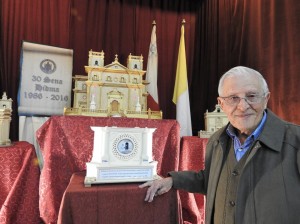 “On February 26, 1986 which happenned to be the tenth anniversary of my father’s demise, I discussed this idea with two of my friends, Raphael Micallef and Tony Terribile, who were very interested in this sector. We all agreed to do something in order to revive this craft and we sent out adverts in the newspapers to announce the set up of this group which we called Għaqda Dilettanti Mudelli ta’ Knejjes (Church Modelling Society). We were very happy when we received a great response from enthusiastic individuals all over Malta. Soon, a commitee was formed and on March 1986, we organized the first exhibition during the first two weeks of Lent wherein the members displayed the works that they had.”
“On February 26, 1986 which happenned to be the tenth anniversary of my father’s demise, I discussed this idea with two of my friends, Raphael Micallef and Tony Terribile, who were very interested in this sector. We all agreed to do something in order to revive this craft and we sent out adverts in the newspapers to announce the set up of this group which we called Għaqda Dilettanti Mudelli ta’ Knejjes (Church Modelling Society). We were very happy when we received a great response from enthusiastic individuals all over Malta. Soon, a commitee was formed and on March 1986, we organized the first exhibition during the first two weeks of Lent wherein the members displayed the works that they had.”It was certainly a great satisfaction to see this society thrive and grow along the years, always adding up new members of various ages. Today, around 400 members form part of this group which operates from its premises at 37, East Street, Valletta.
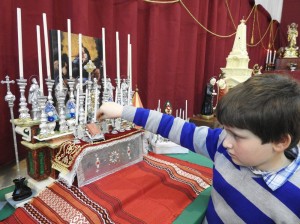 “This year we are delighted to celebrate the 30th anniversary from the establishment of this society,” Pawlu said. “The annual exhibition has been taking place each year. Besides offering the opportunity to showcase our members’ works, this event has served to help our members and the public which visits it, to meditate during the Lent period and to prepare for the Easter celebrations.”
“This year we are delighted to celebrate the 30th anniversary from the establishment of this society,” Pawlu said. “The annual exhibition has been taking place each year. Besides offering the opportunity to showcase our members’ works, this event has served to help our members and the public which visits it, to meditate during the Lent period and to prepare for the Easter celebrations.”A bi-monthly magazine, Il-Knisja Tiegħi (My Church), which was also initiated by Pawlu, is marking its 30th anniversary too. Members have been writing features in it related to different aspects of religious folklore, thereby kindling even further interest in model-making.
Once again this year, the society has organized this exhibition which saw the participation of several of its members. Exhibits varied and included small to large statues of the passion of Christ and Easter, statues of Blessed Mary and several saints, models of altars, church facades and whole churches made of different materials.
 “I hope that I’ll have enough strength to exhibit my large model of St Publius’ church,” revealed Pawlu at one point. “It takes me four weeks to set it up on a large platform and to connect the miniature chandeliers and light fittings to electricity. I am getting old now and such work is very tiring.”
“I hope that I’ll have enough strength to exhibit my large model of St Publius’ church,” revealed Pawlu at one point. “It takes me four weeks to set it up on a large platform and to connect the miniature chandeliers and light fittings to electricity. I am getting old now and such work is very tiring.”Pawlu has been exhibiting this model in a building besides the Floriana Cathecism Museum for many years now, during the feast of St Publius which takes place two weeks after Easter.
“Many people come to visit my model and they are fascinated with it. Tourists take photos besides it and they ask me how I managed to construct it section by section and yet making it look as a whole. I tell them that there are lifetimes of passion invested within it and that it is imbued with a blend of religious meaning and local traditional skills and creativity.”
At 82 years, Pawlu is serene and thankful to see the society which he has founded together with his friends strengthen itself and adding members to it.
“I just wish that it will continue to flourish for very long,” smiled Pawlu as he looked contentedly around him in order to appreciate the beautiful displayed works of the society’s members.
(This article was published in the Easter Supplement which was issued with The Times of Malta dated 21st March 2016)
Travelogue
Archives
| M | T | W | T | F | S | S |
|---|---|---|---|---|---|---|
| « Jan | ||||||
| 1 | 2 | 3 | 4 | 5 | 6 | 7 |
| 8 | 9 | 10 | 11 | 12 | 13 | 14 |
| 15 | 16 | 17 | 18 | 19 | 20 | 21 |
| 22 | 23 | 24 | 25 | 26 | 27 | 28 |
| 29 | 30 | |||||
Recent Posts
- A MATTER OF FATE
- MALTA’S PREHISTORIC TREASURES
- THE MAGIC IS IN THE DETAIL
- THE SELLING GAME
- NEVER FORGOTTEN
- Ġrajjiet mhux mitmuma – 35 sena mit-Traġedja tal-Patrol Boat C23
- AN UNEXPECTED VISIT
- THE SISTERS OF THE CRIB
Comments
- Pauline Harkins on Novella – Li kieku stajt!
- admin on IL-KARNIVAL TRAĠIKU TAL-1823
- Albert on IL-KARNIVAL TRAĠIKU TAL-1823
- Martin Ratcliffe on Love in the time of war
- admin on 24 SENA ILU: IT-TRAĠEDJA TAL-PATROL BOAT C23